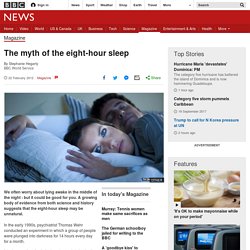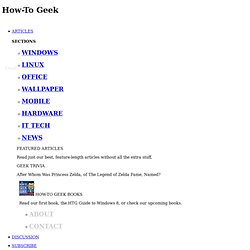

Foods That Help or Harm Your Sleep Slideshow. IMAGES PROVIDED BY: (1) Siri Stafford / Stone / Getty Images (2) Medioimages / Photodisc / Getty Images (3) Lynda Schemansky / age fotostock / Photolibrary (4) Bryce Lankard / Stone / Getty Images (5) Thomas Northcut / Photodisc / Getty Images (6) Bryce Lankard /Stone / Getty Images (7) Blue Line Pictures /Iconica / Getty Images (8) Siri Stafford / Digital Vision / Getty Images (9) PM Images / Taxi / Getty Images (10) Dorling Kindersley / Getty Images (11) Laurence Dutton / Photographer's Choice / Getty Images (12) David De Lossy / Photodisc / Getty Images REFERENCES: National Sleep Foundation: "Food and Sleep.

" Sleep.com: "Eating Before Bed – The Good and the Bad. " HowStuffWorks.com: "How Caffeine Works. " Nemours. KidsHealth.org: "What Is Caffeine. " The myth of the eight-hour sleep. Image copyright Other We often worry about lying awake in the middle of the night - but it could be good for you.

A growing body of evidence from both science and history suggests that the eight-hour sleep may be unnatural. In the early 1990s, psychiatrist Thomas Wehr conducted an experiment in which a group of people were plunged into darkness for 14 hours every day for a month. It took some time for their sleep to regulate but by the fourth week the subjects had settled into a very distinct sleeping pattern. They slept first for four hours, then woke for one or two hours before falling into a second four-hour sleep. Though sleep scientists were impressed by the study, among the general public the idea that we must sleep for eight consecutive hours persists.
In 2001, historian Roger Ekirch of Virginia Tech published a seminal paper, drawn from 16 years of research, revealing a wealth of historical evidence that humans used to sleep in two distinct chunks. Image copyright bbc. So You Think You Can Be a Morning Person? SleepBot Tracks and Analyzes Your Sleep Patterns.
Android: If you’re worried you’re not getting enough sleep but not sure how to keep a close eye on it, SleepBot is feature-packed app that analyze your sleep patterns, integrates with alarm clocks, and more.

SleepBot has a deceptively simple interface; simply install the application and put the SleepBot widget on your home screen. Tap it when you climb into bed and when you wake up. SleepBot supports multiple daily entries (if you sneak in a nap or wake up in the middle of the night and get a little reading done, for example) and compiles all those entries into sleep trend graphs that display average sleep length as well as your sleep/wake patterns and times. In addition it calculates total sleep for span of time and your sleep debt. Whether for personal use or to share with your doctor you can also keep notes related to your sleep and then export the whole thing (notes, sleep record, and all). SleepBot is free, requires Android 1.6+. SleepBot [Android Market] Calculate the Best Time to Nap with This Interactive Nap Wheel. The Take A Nap Wheel: Find The Perfect Time To Take A Nap.
Have you ever wondered what the perfect time is to take a nap?

Do you wake up from a nap and feel more tired than before you went to sleep? Well then you should check out The Take A Nap Wheel. This cool web application is made by Dr. Sara Mednick. This simple application allows you to rotate the wheel to the time you woke up in the morning and based on that, it finds the best time for you to take a nap. Basically, the wheel has two circles attached to it, where those two circles match is the ideal nap point. Features: Easy to use.Calculate when short-wave and REM sleep are balanced.Finds the perfect time to maximize your nap.Created by Dr. Find The Sleep Wheel @ saramednick.com. ZEO. Wake-up ligh.